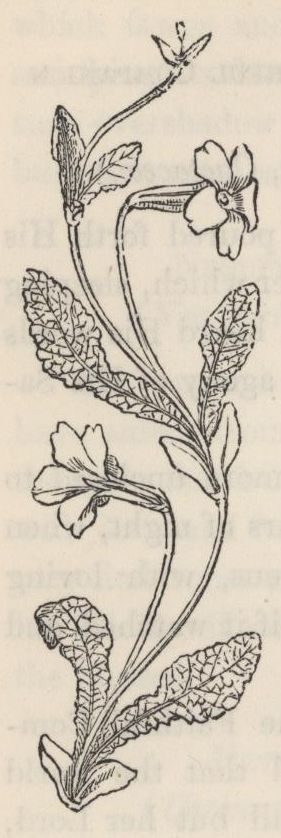






Let those who are too quick-sighted to the faults of others, enter into themselves; and, remembering that none of us are perfect, let them refrain from censuring their neighbour, lest in blaring him, they condemn themselves.
In clothing the earth with beauty, during the bright month of May, Nature pays homage to the Queen of Heaven; and, giving us her fairest flowers to deck our heavenly Mother’s altars, she tells us to render our hearts worthy of Mary, and to present them to her with our flowers.
The Heath, which grows spontaneously among our hills and mountains, and loves to be alone, resembles that solitude in which the heart communes with God. Those who have tasted its delights, learn to despise all fleeting pleasures, and seek in God their only consolation.
Far from the bright gardens where bloom our gayer flowers, and hidden among its own green leaves, the Wild Heartsease flourishes in happy seclusion, seeming to reflect the modest retirement which veiled the early years of Mary’s holy life.
When the reign of sin is over, and the soul finds how vain and empty is all but God, she turns to her Creator; and, in love and sorrow, she seeks to live for Him alone. Like the wild Heather, which avoids the haunts of men, she flies the world with its gay scenes; and, heedless of that world’s opinion, she seeks but to please her Lord.
The Hemlock has ever been considered emblematic
of death; its fatal qualities are well known; and among
the Greeks, those whom the law condemned to die, were
often forced to drink the hemlock’s juice.
Thus did Socrates perish, sacrificed by his ungrateful
country, to the jealous hate of those who felt his virtues
to be a tacit reproach to the vices of their own lives.
How often is this example followed by the world!
and how often do worldlings condemn what they secretly
admire, but what they have not the courage to imitate!
Unnoticed by the brilliant flowers that bloom around me, and oft unseen by human eyes, I waft to Heaven the sweet incense of my prayers, endeavourmg, m my own silent language, to attract men to know and love Him who created me.
How mean, how contemptible appear the works of man, when compared with those of God! What painter could imitate the colouring of the Hibiscus? Who could impart to it those delicate tints but the mighty Being, at whose bidding spring forth from the cold, dark ground, those beauteous flowers, which, by their rich and varied hues, defy the artist’s skill.
In all the works of God, we learn the lesson that Order is the great law by which the whole creation is regulated. It is the law that rules the heavenly spheres, bids the bright orb of day rise and set upon the world, guides the planets in their starry course, and brings, in due time, the varied seasons to the expecting world.
Censure is bitter as Horehound to a young and ardent spirit; but, if as distasteful as Horehound, it also possesses the salutary qualities of that plant. Though it sometimes embitters our joy, and casts a damp over youthful ambition, it also restrains us from harm, and recalls our steps from the path of danger.
The clinging Hoya is emblematic of submission; for its docile stem follows each movement of the hand that trains it, and it wreathes around the supporting trellis its garlands of dark green leaves and odoriferous flowers. Perhaps it was at the holy house of Nazareth that the lovely Hoya first learned submission, and that the pure hands of Mary first taught it that lesson, of which she herself has left us so bright an example.
The early and secluded life of St. Joseph may be portrayed by the wild Hyacinth, which, bending its meek head towards the earth, and shrouded by its gay companions, appears wishful to conceal its purple flowers, emblems of the virtues which, in after years, made St. Joseph so dear to the heart of Jesus.
Our Divine Lord has said: “Blessed are the pure of heart, for they shall see God.” Blessed indeed are those who, by their spotless and angelic lives, merit the privilege of angels, that of beholding God. For, dwelling in their souls, and encompassing them with a special love. He grants them, even on earth, some glimpse of that divine beauty, some foretaste of those heavenly delights which fill the angels and the blessed spirits with eternal joy.
